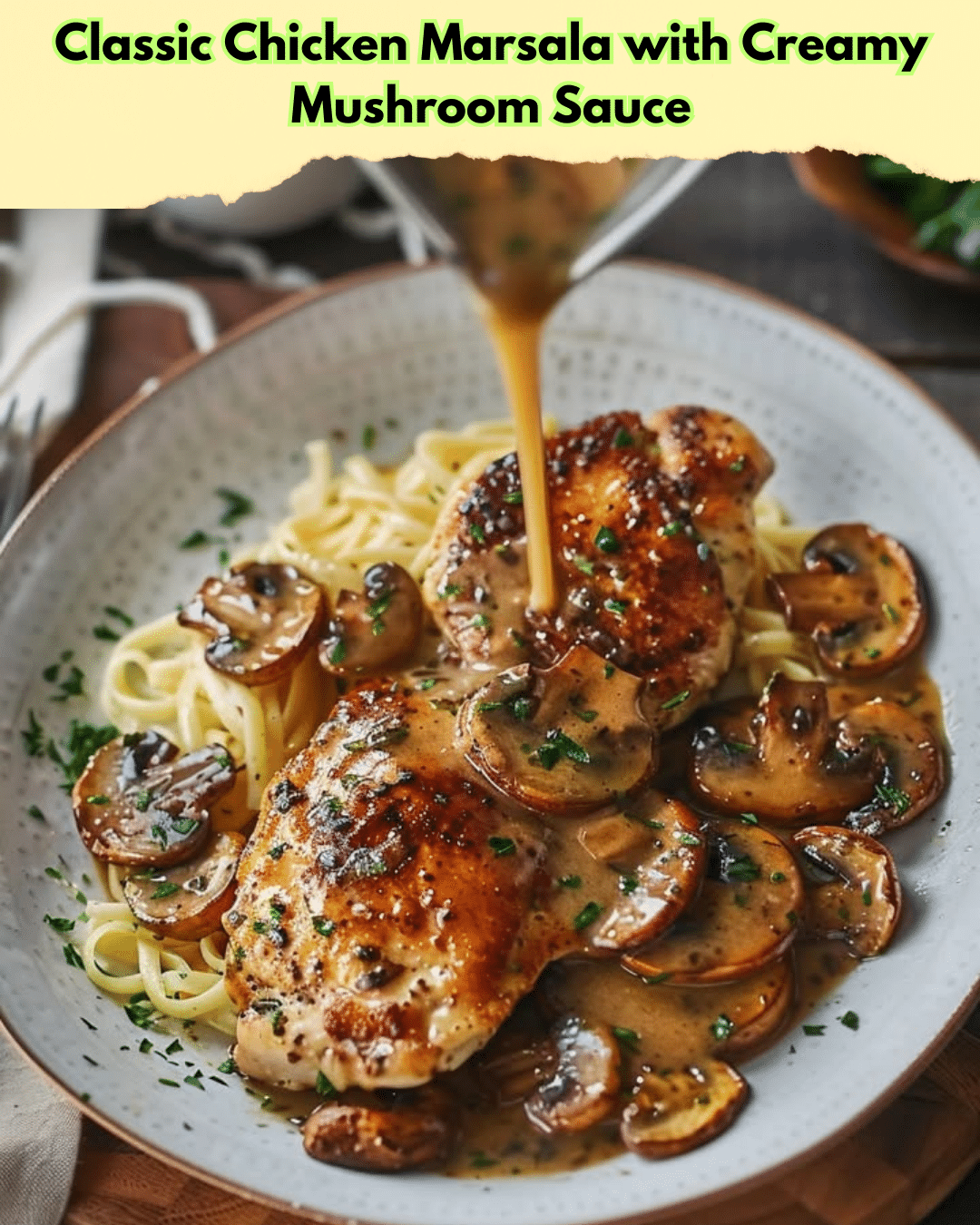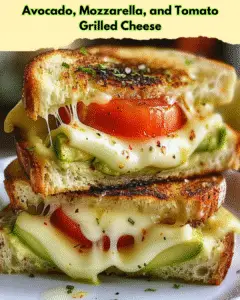Classic Chicken Marsala with Creamy Mushroom Sauce: A Timeless Culinary Delight
Enjoy the classic taste of Chicken Marsala with a creamy mushroom sauce. This authentic Italian dish brings a restaurant-quality meal to your home table, marrying tender chicken breast, savory mushrooms, and the rich flavors of Marsala wine in a smooth, creamy sauce. Each bite offers a comforting taste of tradition and sophistication, perfect for a special occasion or adding a touch of elegance to everyday dinners.
The allure of Chicken Marsala lies in the depth of its flavors and the balance of its textures. The chicken, cooked to perfection, is both succulent and full of flavor. The earthy mushrooms add an umami richness, while the Marsala wine, with its distinct sweetness, ties the whole dish together. Paired with a creamy sauce, this dish offers a luxurious culinary experience.
This dish not only tantalizes your taste buds but also delights visually. With its beautiful array of colors and the aromatic waft of Marsala wine, it’s a sensory feast. Whether you are hosting a dinner party or looking to treat yourself, Chicken Marsala with creamy mushroom sauce is a sure favorite.
Quick Recipe Highlights
- Flavor Profile: A savory combination of tender chicken and rich mushroom sauce with the sweetness of Marsala wine that enhances the overall flavor.
- Texture: The dish boasts a contrast of succulent chicken breast with a velvety mushroom sauce, ensuring a delightful mouthfeel with every bite.
- Aroma: The enticing fragrance of Marsala wine and fresh mushrooms fills the kitchen, creating an inviting and cozy atmosphere.
- Visual Appeal: A harmonious blend of golden-brown chicken and creamy sauce with vibrant mushrooms makes for an impressive dish presentation.
- Skill Level Needed: Requires an intermediate grasp of cooking techniques, such as browning and sauce reduction, to master the flavors perfectly.
- Special Equipment: A good quality frying pan is crucial for achieving the right sear on the chicken and developing a flavorful mushroom sauce.
Recipe Overview
- Difficulty Level: This dish is of moderate difficulty, as it requires careful attention to sauce development and chicken cooking to ensure a restaurant-quality result.
- Category: Fits well into the category of main courses, offering a hearty and satisfying meal option that stands out.
- Cuisine: Rooted in Italian culinary tradition, Chicken Marsala is a classic example of the skillful use of wine in cooking to enrich flavors.
- Cost: While Marsala wine and mushrooms can add to the cost, the overall expense remains reasonable, especially given the quality of the meal.
- Season: Perfect year-round, but especially delightful in fall and winter when warm, comforting meals are most desired.
- Occasion: Ideal for both casual family dinners and more formal gatherings, where you aim to impress without spending hours in the kitchen.
Why You’ll Love This Recipe
The taste and texture of this classic Chicken Marsala with creamy mushroom sauce create an indulgent, restaurant-style experience at home. The chicken remains moist and tender, complemented perfectly by the rich, creamy mushroom sauce that has just the right hint of sweetness from the Marsala wine. It serves as a delicious centerpiece for a hearty meal, satisfying both gourmand and casual diners alike.
From a preparation standpoint, this recipe is convenient and manageable, even for those with a busier lifestyle. With a total preparation and cooking time of less than an hour, you have a quick yet sophisticated dish ready for the table. The ingredients are easily available, reducing time spent searching for specialty items.
Nutritionally, this recipe offers a balanced intake of protein from the chicken and vital minerals from the mushrooms. The dish is rich yet won’t leave you feeling sluggish, striking a healthy balance important for everyday dining. The choice to create the dish with a creamy sauce adds to its texture and flavor profile without excessive use of heavy cream.
Socially, Chicken Marsala is a dish that impresses. It’s a perfect way to entertain friends and family, showcasing your culinary skills without requiring professional chef training. Its rich flavors and elegant presentation make it a frequent choice for dinner parties and gatherings.
Cost-effectiveness is another advantage of this recipe. It recreates a restaurant-style dish at home for a fraction of the cost, using readily available ingredients. By making it yourself, you not only save money but also have control over the quality of ingredients used, ensuring a superior dining experience.
Historical Background and Cultural Significance
Chicken Marsala originates from Italy, specifically the region around the town of Marsala in Sicily. It draws from the centuries-old tradition of pairing meats with fortified wines, a culinary innovation thought to enhance flavors and preserve ingredients. Marsala wine, with its unique sweetness and robust flavor, becomes the backbone of this dish.
Initially designed as a simple country meal, Chicken Marsala reflects the Italian ethos of emphasizing fresh, quality ingredients with a straightforward cooking technique. The dish has evolved from its humble roots into a globally recognized delicacy, often featured in Italian restaurants and beloved by many.
In terms of cultural importance, Chicken Marsala is seen as embodying the Italian way of living—balanced, rich, and full of life. It holds a special spot among Italian-American cuisine, attesting to the successful culinary fusion experienced by Italian immigrants in the early 20th century.
Through regional interpretations, Chicken Marsala has seen numerous variations. Across Italy, chefs may add secret touches, vary the type of mushrooms, or tweak the spice blend, creating a rich diversity within a unified culinary tradition. Its adaptability ensures that every iteration adds something unique, ensuring the dish’s continued evolution and popularity.
Ingredient Deep Dive
Chicken breast is the star of Chicken Marsala, chosen for its lean yet tender nature. Its origins date back to early domestication practices, and it has become a staple protein in modern diets worldwide. Nutritionally, chicken provides high-quality protein, essential for muscle development and maintenance. When selecting chicken breasts, look for firm, moist pieces without any discoloration. Store them in the refrigerator and use them within two days for optimal freshness or freeze them if storing longer.
Marsala wine gives this dish its characteristic flavor profile. Produced in the Sicilian town of Marsala, this fortified wine has a rich history dating back to the 18th century. It’s often used in cooking to create depth and complexity. When choosing Marsala wine for cooking, a decent-quality dry variety works best, enhancing the savory notes of the dish. Store the bottle in a cool, dark place to maintain its integrity for months.
Mushrooms add an earthy depth to the sauce. These fungi have been used in foods for centuries due to their texture and flavor. Rich in antioxidants and minerals like selenium and copper, mushrooms contribute to a healthful dish. Select firm mushrooms, avoiding slimy or discolored ones, and store them in a paper bag in the refrigerator to prolong their shelf life.
The creamy sauce component is vital for texture and richness. Typically, heavy cream is used, yet alternative options are available for those seeking lighter varieties, like half and half. Store cream in the coldest part of your fridge, sealed tightly, and use it before its expiration date to ensure smooth consistency and flavor.
Common Mistakes to Avoid
- Using low-quality Marsala wine can result in a loss of flavor refinement, making the dish less vibrant.
- Overcooking the chicken will lead to dryness; a careful eye toward cooking time prevents this.
- Failing to properly brown mushrooms can leave them bland, detracting from the dish’s complexity.
- Reducing the sauce too quickly or at too high a heat can cause separation, affecting texture.
- Skipping the flour dredging for chicken can impede the sauce’s ability to adhere properly.
- Ignoring ingredient freshness affects both taste and safety; prioritize high-quality, fresh ingredients.
- Adding cream too early in the cooking process may lead to curdling; it should be added at the end.
- Using inadequate seasoning will result in a bland dish; salt and pepper should accentuate without overwhelming.
Essential Techniques
Proper basting of the chicken during cooking is crucial for maintaining moisture and enhancing flavor. Basting helps to uniformly distribute juices throughout the meat. Mastering this technique involves timing precision and attention to pan signals, such as the initial sizzle when basting begins. Visual cues include the chicken taking on a golden hue without burning.
Achieving the right consistency for the sauce is another essential skill. This involves balancing heat and cooking duration to allow the reduction of liquid into a lush, thick sauce without it becoming overly dense. The goal is a sauce that coats the back of a spoon, succinctly capturing the blend of Marsala, chicken juices, and cream.
Perfectly browning mushrooms is a skill requiring the use of high heat without stirring constantly, allowing the mushrooms to caramelize. This enhancement in flavor is a result of the Maillard reaction, producing a richer taste profile. Monitoring for a uniform golden color and listening for a gentle sizzle indicates success.
Pro Tips for Perfect Classic Chicken Marsala
Temper your chicken breasts by letting them sit at room temperature briefly before cooking, ensuring even cooking and preventing them from seizing when they hit the hot pan.
Flour dredging not only aids in sauce adhesion but also contributes to a golden-brown crust on the chicken. Ensure the flour coating is even and excess is tapped off.
Balance Marsala sweetness by adjusting the quantity to taste. Some prefer a pronounced wine presence, while others may desire a subtler hint; tasting as you cook allows personalized customization.
Invest in a high-quality, heavy-bottomed skillet, which distributes heat evenly across its surface. This prevents hot spots and ensures consistent cooking.
Sauté mushrooms without stirring constantly. Allow them contact with the pan to brown, unlocking deeper flavors.
Use culinary grade Marsala wine for an authentic taste, favoring its potency over cooking wines, which often lack depth.
Variations and Adaptations
Regional variations across Italy include adding different mushroom varieties, such as porcini, for intensified earthy flavors. This adaptation highlights local ingredients and demonstrates versatility.
Seasonally, this dish can adapt with the incorporation of seasonal herbs like sage or rosemary to complement autumn and winter tables. Spring onions or leeks can freshen it for warmer weather.
Dietary modifications involve using gluten-free flour for dredging or substitute cream alternatives to create a lactose-free version, ensuring allergy-friendly dining without compromising flavor.
Enhance the dish’s flavor by introducing garlic or shallots into the sauce, elevating its savory profile, or spice it with a hint of red chili flakes for added warmth.
A smooth or chunky sauce adjustment offers textural diversity; blending some components with an immersion blender creates a different mouthfeel.
Presentation can shift from rustic to refined with plating changes. Consider a bed of wilted greens as a backdrop or a sprinkle of parsley for a burst of color.
Serving and Presentation Guide
Plating techniques begin with maintaining a clean base, free of sauce splashes. A simple white plate often proves the best canvas for the dish’s colors to pop, highlighting the golden-brown chicken and porcini-flecked sauce.
For garnishing, consider a fresh herb scatter like parsley or basil, which adds color contrast and aromatic depth, lending a fresh note to each bite.
Traditional accompaniments include a side of creamy mashed potatoes or al dente pasta, with each option providing a complementary starch profile to suit different tastes.
Modern serving suggestions might employ the use of a trio of colorful roasted vegetables to mirror the dish’s sophistication.
Consider serving temperature; this dish excels when served warm, maximizing flavor distribution and cream texture.
Observe portion control tips, aiming for balance between generous servings and plate room for artistic arrangement, enhancing visual appeal.
Wine and Beverage Pairing
A traditional Marsala pairs beautifully with this chicken dish, echoing its flavor notes and providing a seamless palate experience. Choose a quality brand to elevate dining experiences.
For non-alcoholic alternatives, consider a sparkling apple cider or a grape juice, maintaining the sweetness and acidity without the alcohol content, suitable for inclusive dining.
Coffee and tea pairings can provide a light end to the meal, with a subtle black tea offering a gentle counterpoint to the meal’s richness.
Pay attention to beverage temperatures; matching wine temperatures to room climate ensures consistent enjoyment, while chilled non-alcoholic options offer refreshing balance.
Serving suggestions include offering a shooter of Marsala on the side for those desiring an intensified taste exploration, celebrating the dish’s entirety.
Storage and Shelf Life
Proper storage involves refrigerating leftovers in airtight containers, ensuring the sauce covers chicken completely to prevent drying out.
Temperature requirements demand refrigeration at 40°F (4°C) to maintain freshness safely for up to three days.
Choose containers like glass or BPA-free plastics that allow visual inspection and stack neatly, saving space.
Watch for signs of spoilage, such as changes in color, texture, or odor, discerning it’s time to discard rather than consume.
Reheating instructions recommend gently using the stovetop method over microwave regeneration, maintaining sauce consistency and temperature control.
Freezing guidelines suggest separating chicken from sauce, preventing texture compromise when thawing, with proper reassembly before serving.
Make Ahead Strategies
Plan your prep timeline by handling chicken and sauce components separately before assembly closer to serving time, maintaining each element’s quality.
Store elements individually between steps, ensuring cold chain integrity and fresh-tasting results in final assembly.
Assessing quality impact involves reassessing the seasoning post-reheating to ensure flavors remain balanced and vibrant.
Assembly tips involve bringing sauce to appropriate thickness and finishing with fresh herbs immediately before service.
Reheating guidelines recommend simmering rather than microwaving, which can separate or change sauce viscosity.
Fresh element additions like grated Parmesan or fresh herbs to a reheated dish revive and enhance flavors before plating.
Scaling Instructions
Consider halving the recipe by proportionally dividing ingredients, paying special attention to nuanced elements like seasoning adjustments for taste balance.
Doubling or tripling may require equipment reassessment, ensuring pots and pans accommodate increased volume without overcrowding, which impacts cooking quality.
Timing modifications acknowledge the increased mass requiring slightly longer cooking time while monitoring for visual and temperature cues to prevent over- or undercooking.
Storage considerations extending involve having sufficient space for leftovers or prepped components, optimizing organizational efficiency for quick access.
Nutritional Deep Dive
The macronutrient breakdown reveals a balance of protein from chicken, healthy fats from olive oil, and carbohydrates determined by selected side complements like pasta or mashed potatoes.
Micronutrient analysis highlights potassium and selenium in mushrooms, contributing positively to dietary profiles, supporting a healthy immune function.
The dish delivers health benefits, offering a protein-rich meal to aid recovery, with mushrooms’ antioxidant properties supporting cellular renewal.
Dietary considerations allow alteration flexibility for various needs, such as gluten-free or lactose intolerancy, with adjustments without flavor compromise.
Assessing portion involves recognizing controlled scatter plating, which aids portion control while maintaining visual appeal, appealing to health-conscious diners.
Tips for weight management focus on choosing lean chicken portions and managing sauce quantities, contributing to a lower calorie intake without sacrificing the dish’s matchlessness.
Dietary Adaptations
Gluten-free diets require substituting all-purpose flour for gluten-free alternatives in chicken dredging, ensuring inclusive enjoyment while preserving textures.
For dairy-free requirements, coconut cream or almond milk offers a suitable creamy texture, slightly modifying flavor profiles with their unique characteristics.
Vegan adaptations prove more complex, simulating chicken with plant-based meat substitutes and Marsala’s non-alcoholic counterpart for a close approximation.
Low-carb iterations possibly lower carbohydrate pairings with zoodles (zucchini noodles), prioritizing the Marsala’s defining sweetness within metabolic goals.
Keto-friendly solutions utilize full-fat cream for sauce richness while relying on olive oil for deep frying, imminently compliant with diet criteria.
Paleo practice versions substitute coconut flour for dredging, together with compliant fats and side enhancements of roasted vegetables over processed sides.
Low-FODMAP implementations adapt, observing dietary regulations to avoid triggering digestive issues by mindful ingredient selection.
Troubleshooting Guide
Address texture issues by reheating gently, checking sauce consistency closely during cooking to ensure lush, rich viscosity without granularity.
Flavor balance solutions involve tasting sauce mid-cook for sweet-to-savory tolerance, adjusting salt, pepper, or Marsala for corrective ratios.
Temperature problems include tempering ingredients sensibly, ensuring pan readiness, and mutually complementing temperature compromises across assembly components.
Reconcile equipment challenges by checking heat distribution and pan suitability, rectifying inefficient elements with appropriate cookware, avoiding flavor misdirection.
Ingredient substitutions advice highlights options like vegetable stock for increased depth or suitable nondairy milk applications within dietary constraints.
Timing concerns address distraction prevention, enhancing outcomes by focusing consistently on the components’ specific timing needs, ensuring optimal holistic harmony.
Recipe Success Stories
Join a community richly enriched by exchanging success stories—a universal chorus of satisfied taste enthusiasts highlighting unique personal renditions.
Be inspired by varied adaptation journeys, from those achieving dietary balance without sacrificing iconic authenticity to youthful culinary explorers learning new skills.
Reader suggestions breathe life into iterative improvements, pushing boundaries with modern interpretation, ensuring perpetual relevance alongside traditional mastery.
Photography tips derived from fellow creators enhance engagement; capturing the visual beauty through proper lighting and creative presentation enhances shared experiences.
Explore feedback from those trialing substitutions broadened horizons, inviting futures for shared knowledge exchange, deepening traditional recipes’ cultural and universal diversifications.
Frequently Asked Questions
Q: Can I use a different type of wine?
A: While Marsala is traditional for this recipe, you can substitute with dry sherry or a sweet Madeira. This will alter the flavor profile, bringing a unique twist to the dish. Be sure to adjust the amount of sweetness to suit your taste.
Q: How do I avoid soggy chicken?
A: Ensure the skillet is preheated before adding the chicken. Brown each side quickly, creating a crust that prevents moisture loss, and only return the meat to the sauce shortly before serving to maintain its texture.
Q: Is it possible to prepare elements in advance?
A: You can pre-make the sauce and store it separately in the fridge for two days. When ready to serve, reheat it while preparing the chicken fresh to maintain both taste profiles’ vibrancy.
Q: Can I replace the mushrooms?
A: Yes, if you prefer a different texture or flavor, consider alternatives like tofu, eggplant, or bell peppers. Each selection will bring its flair while maintaining the essence of the dish.
Q: What sides go well with Chicken Marsala?
A: Traditional sides include pasta and potatoes. To keep it lighter, roasted seasonal vegetables or a simple green salad offer complementary balancing and refreshing crispness.
Q: How should leftovers be reheated?
A: For the best results, gently reheat leftovers on medium heat on the stove to keep the chicken from becoming tough. Add a splash of cream to refresh the sauce as it warms.
Q: Is this dish suitable for a keto diet?
A: Absolutely! Simply monitor the sauce ingredients closely, using keto-friendly flour alternatives and pairing it with appropriate sides like leafy greens or riced cauliflower.
Q: Can I store the cooked dish?
A: Leftovers can be refrigerated safely for up to three days. For longer storage, separate the chicken and freeze it adjoined with sauce shortly before serving for freshness integrity.
Q: How can I thicken the sauce?
A: If desired, use a cornstarch slurry or double the amount of cream, allowing it to reduce slowly until the sauce reaches a creamy thickness that coats the back of a spoon.
Q: Why is my sauce separating?
A: Sauce separation can be rectified by ensuring the cream is added slowly over medium heat and stirring consistently within gentle cooking processes to maintain an emulsified sauce.
Additional Resources
Explore additional classic Italian recipes, such as Osso Buco or Saltimbocca, each containing lessons valuable in mastering complementary culinary techniques emphasizing balance and flavor cooperation.
Engage in technique guides for browning meat or developing skill precision in a perfect sauce reduction, which extends into all successful Italian dish endeavors.
Delve into ingredient information specifics, such as varieties of wine’s uniting influence at a dish’s heart, broadening culinary perspectives.
Review equipment recommendations under express interest, facilitating smart kitchen investments and unlocking refined cooking capabilities linked to nuanced recipe secrets.
Investigate seasonal variations that balance warmth and core comfort, evoking specific sensory culinary experiences tied to guided adaptability to individualistic enhancements.
Print
Classic Chicken Marsala with Creamy Mushroom Sauce
Description
A traditional Italian-American dish featuring sautéed chicken breast with a creamy Marsala wine and mushroom sauce.
Ingredients
For the Crust:
- 4 boneless chicken breasts
- 1 cup mushrooms, sliced
- 1 cup Marsala wine
- 1/2 cup chicken broth
- 1/2 cup heavy cream
- 2 tablespoons olive oil
- Salt and pepper to taste
Instructions
1. Prepare the Crust:
- Season the chicken breasts with salt and pepper.
- Heat olive oil in a large skillet over medium heat. Cook chicken until golden brown on both sides and cooked through, about 5 minutes per side.
- Remove the chicken and add mushrooms to the skillet. Sauté until tender, then add Marsala wine, chicken broth, and cream. Simmer until the sauce thickens. Return chicken to skillet and coat with sauce.
Notes
You can customize the seasonings to taste.




